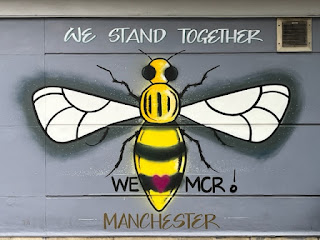Partnerships are the golden thread in Manchester
Greater Manchester records some of the highest rates of homelessness in the UK. It is also seeing some real movement in addressing that issue.
My #1 observation in Manchester is that deliberate cross Council relationships can see results.
Thanks to Molly Bishop, Strategic Lead for Homelessness at the Greater Manchester Combined Authority (GCMA)
who was so kind with her introductions and in providing me a crash course in
Manchester's approach and history in partnerships.
Greater
Manchester has long experience working together. That joint commitment was
evident on the stops I made last week to Manchester, Rochdale, Salford and
Wigan Councils, four of the ten that make up the Greater Manchester Combined
Authority (GMCA).
I
loved how Molly described it:
"It
all comes down to relationships. That's the foundation of how we work in
Manchester.
"Our
greatest asset is the relationships that people have and it’s the golden thread
that ties things together. "
In
the homelessness space, GMCA convenes and facilitates work in four focus areas:
- ending rough sleeping
- driving affordable housing for people experiencing homelessness
- preventing homelessness
- driving health inclusion.
The
GMCA's theory of change looks to integrate work at a neighbourhood level in
each local government area, while utilising collective outcomes for stronger
lobbying and better grant applications.
From
my quick visits, the emphasis on local area identity and focus was a particular standout in Greater Manchester,
especially in places like Wigan, where a strong focus on working for the local
community, rather than an individual service, helped break silos and improve
results in homelessness response.
The
Greater
Manchester Model White Paper on unified services outlines six key features
that drive this work. Knowing that successful partnerships take work, I found
these really useful in thinking about what factors might need to be in place to
enable success.
Below
is my summary of these points (taken from p.10):
- Geographic
alignment: The
neighbourhood level is the building block for local care organisations and
the foundational unit for delivery recognised across public service
organisations.
- Leadership
and accountability: An emphasis on
leading for the people and the place as opposed to purely on an
organisational or functional basis.
- One
workforce: There is a
look and feel of one public service workforce functioning together,
unrestricted by role titles or organisational boundaries working for the
place and people.
- Shared
financial resource: There are
means in place to pool transformation and reform funds for collective
benefit and there is also a single commissioning function which pools
budgets.
- Programs,
policy and delivery: All strategic
plans and change programmes work towards a common goal of integrated
public service delivery, with multiple integrated delivery models coming
together as a single neighbourhood delivery model
- Tackling barriers and delivering devolution: Each locality has a formal mechanism to identify, act on and escalate issues that impact on delivering the most effective services for people or act as a barrier to wider and deeper integration.
More
info:
Prevention
Strategy and Action Plan for Greater Manchester (2021)
Combined
authorities: https://www.local.gov.uk/topics/devolution/devolution-online-hub/devolution-explained/combined-authorities
Thanks Molly Bishop - Greater Manchester Combined Authority









Great links. Thanks Leanne.
ReplyDeleteThanks for sharing this Leanne. The summary of points are very useful as it points to a systemic and cultural changes required in approaching an issue together. Great practical lessons and reflections.
ReplyDelete